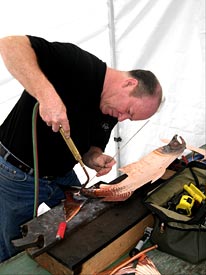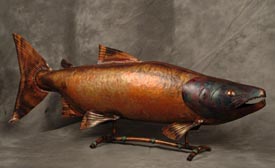Massey Copper: Inspired by the Organic Form
 Copper artist Walter Massey working with his son, Marc
Copper artist Walter Massey working with his son, Marc Photograph by Elizabeth Becker
Walter Massey took a number of detours on the way to finally turning his art into a business. He worked as an aircraft welder, a blacksmith shop production manager, and pursued undergraduate and graduate studies in psychology and literature. "There was a time I tried to be a police officer, an EMT, and I studied to be a counselor," he adds.
Massey also studied art and eventually developed his own unique way of fabricating copper that utilizes his training as a welder. This led to the founding of his company, Massey Copper, in Port Townsend, Washington, where he creates a variety of art pieces, as well as teaches others how to blend fabrication with welding.
Massey's love of creating began at an early age. He grew up in an artistic family in South Carolina, where he spent hours painting alongside his grandmother in her garden. As a teen, he became interested in "structural" media and began building intricate model ships, automobiles, airplanes, and historical armor and weaponry. While in school at Seattle Pacific University, he learned lost wax casting and began designing and making small sculpture jewelry in silver.
His technique today involves first creating his sculpture out of paper using poster board and masking tape - an idea conceived in his childhood.
"I would sit at my grandmother's knee while she would sew dresses, and from that, I got an idea that I could conceptualize anything if I could mock it up with paper and tape and make all my mistakes that way," he says. "Then, when I got to the copper, it would actually be easier than the paper because it does bend and it's flexible."
 Massey working in his Massey Copper studio
Massey working in his Massey Copper studioPhotograph by Elizabeth Becker
Massey has fabricated life-sized sculptures of people, animals, and trees. "I love anatomy," he says. "My self-imposed training is the Renaissance - all the greats [such as] Michelangelo." His Port Townsend community has an affinity for gardening and organic trees, so some of his recent work has included architectural garden sculptures. "I wanted to flow with that," he says. "So, I find myself doing gates, organic forms, and interesting arbors."
He is currently preparing to launch a five-month project to create a large madrone tree for a world-class designer home on Bainbridge Island. He has created this particular tree before, which was so large that it extended up through the room's skylight.
Creating a life-sized tree is problematic, and Massey is always working to develop better ways to fabricate figures in the round.
"Three-dimensional artwork is difficult," he says. "It's hard to make things look good from every angle. For me, it's a great challenge…I really like what I do, but there's always a part of it that's not where I want it."
Massey teaches his technique in his own shop, as well as the Wooden Boat School in Port Townsend. He likes to create a party atmosphere in his classes, and complete novices can participate, producing a small sculpture or fountain in a single day.
"I teach people how to take a thought and fabricate it in three-dimensional reality," he says. "I get them to participate in an artistic kind of way in a machine shop atmosphere."
He teaches what he calls an old-fashioned method involving the welding of phosphorous copper rods using gas torches, which is a less expensive method of fabricating copper. His students learn the basics of making a three-dimensional form from flat-sheet copper, including cutting and fabricating the copper, as well as texturing it through reticulation. Rather than casting the metal, he teaches them to create a wrinkled effect by burning the edge with the gas torch.
 NW Salmon by Massey Copper
NW Salmon by Massey Copper Photograph by Elizabeth Becker
For his own custom pieces, however, he sometimes works in a more complex way. He might use a pneumatic hammer and an electric welder with dioxide copper rods in order to achieve the results he envisions. The dioxide copper rods maintain their color better than the phosphorous copper rods, which start to look silver when you grind them down. The pneumatic hammer is akin to carving the copper from the back side, but the electric welder requires face protection, while the gas torches can be used without safety gear.
Massey gets his copper from Alaska Copper & Brass in Seattle, and he sometimes works with silicon bronze as well. His work is on public display in eight states and in private collections in 23 states and four countries.
Massey's wife, Norma, works with him in the business, and all five of their now grown children apprenticed with him and are capable of teaching his technique.
"Helping Dad in the shop was their after-school job from about 10 years old to graduation from high school," Norma says.
While Massey loves creating art, he never forgets that he runs a business. "The story of my life is that I always have my foot in two camps," he says. "I borrow from the machine shop fabricating experience, and I also borrow from the more art school "artsy" way of doing things. To me, that's the game."
It's people who inspire him most, though. "The art's exciting," he says, "but I like the fact that it delights people."
Resources:
Also in this Issue:
- Copper Art Shines in the Garden
- Massey Copper: Inspired by the Organic Form
- The Sky's the Limit for Celestial Copper Artist Phil Gauthier
- Copper Jewelry in the Early Americas
- The Five Elements: Group Sculpture Exhibition Opens at Ch'i Contemporary Fine Art
